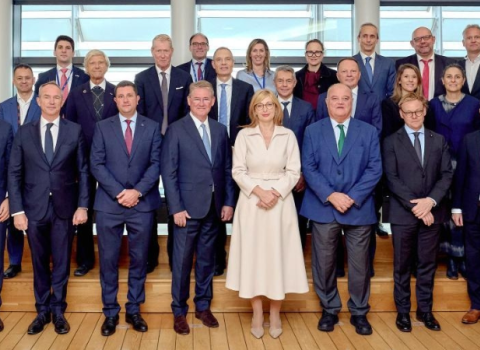To speed progress, the new Commission will need to tackle obstacles to a single EU energy market, simplifying and rationalising a tangle of priorities,say leading researchers and energy policy experts interviewed for this article. That is a critical first step in creating a strategy that can deliver a low-carbon future.
“We have to get some order into the policy,” says Joan MacNaughton, chairwoman of the World Energy Council’s World Energy Trilemma study group, and a former director general of energy for the British government. “At the moment, you have a huge number of policies, both at the member state level and the European level, and the interactions between them are not being properly analysed and understood, and they’re resulting in some unintended consequences.”
While many have pushed for strong 2030 targets on carbon, renewables and efficiency, others, like coal-dependent Poland, have resisted. Even those nations that want to move quickly are struggling with high costs, most notably Germany, where a nuclear phase-out and strong push towards renewables have caused electricity prices to spike. Those skyrocketing bills have angered many, and worried other nations looking to emulate Germany’s low-carbon ambitions.
Conflicts in the Ukraine and Iraq, however, have now increased the urgency of speeding Europe’s transition to a lowcarbon economy—and that’s put the integration of network systems and regulations at the top of the political agenda. In September, European Commission President Jean-Claude Juncker appointed two commissioners to handle energy portfolios—one for energy union and one for energy and climate—with the goal of breaking down policy silos to speed change.
Which new technologies have the best shot at achieving Europe’s energy roadmap goals? Experts say sustainable transport and second-generation biofuels have huge potential—but need more research support. At the same time, rapid expansion and upgrading of Europe’s electricity grid is vital to integrating renewable power generation from wind and solar panels—and that shift also requires new technologies.
For 2030, MacNaughton envisions a simple, flexible regime, driven by an ambitious and binding carbon dioxide reduction target. Other targets, such as those for renewables or energy efficiency, should be secondary to that overarching goal, technology neutral and preferably time-limited, especially if they include subsidies, MacNaughton argues.
That approach, she says, would give nations the flexibility to design policies tailored to their individual circumstances, as President Obama is seeking to let US states do under his new emissions reduction proposal. Also critical, MacNaughton believes, are changes to the EU Emissions Trading System that gradually lift the price of carbon, and removal of regulatory and other barriers that hamper development of Europe-wide markets for electricity and gas.
Europe’s weak economy has badly undercut the Emissions Trading System, which was meant to be a centrepiece of carbon-cutting efforts. A glut of permits has kept the cost of polluting too low to drive investment in low-carbon infrastructure, experts agree, noting that a well functioning system would have made cheap American coal expensive to burn in Europe, preventing its widespread use.
Most experts agree that a higher carbon price, imposed either through a tax or a reformed trading system, will be essential to driving innovation. Beyond that, though, there are other steps the Union should also be taking, particularly in research and development, scientists
say.
Doug Arent, acting director of the Strategic Energy Analysis Center at the National Renewable Energy Laboratory in the US, says the EU does a good job of supporting energy researchers with multiyear grant awards and contracts that enable engineers and scientists to build up staff and pursue long-term ideas.
Where Europe has fallen short, he says, is in building an innovation pipeline like the one that helps bring new technologies to market in the United States. American universities and labs, he believes, are more aggressive about transferring technologies to the private sector, where they can be commercialised and scaled up. For example, he says, the Advanced Research Projects Agency-Energy lends US government support to early-stage ideas that have the potential to be transformative, but are not yet developed enough to win private sector backing. And the National Renewable Energy Laboratory helps connect small companies with angel investors and venture capitalists.
“If you look at the innovation value chain, it’s actually pretty substantial and many, many, many steps in the United States. I’m just not aware if that exists, or how robust it would be in Europe,” he says. “It’s rare to find a Silicon Valley or a Boston pharmaceutical hub in Europe. Could policymakers do more to encourage that?”
Europe’s Strategic Energy Technology Plan, or SET-Plan, launched in 2008, was intended to spur the development and deployment of new technologies, but it has got off to a slow start, in part because of a siloed approach to investing in new energy technologies and the failure to grapple with the impact of new technologies on the existing energy system.
The good news is that a revised SETPlan focused on an integrated EU energy market is in the works, and will be launched in 2015 (see page 22).
The EU’s Horizon 2020 research and innovation budget includes €5.9 billion for energy, all of which will flow to SETPlan priorities. But that sum falls far short of the roughly €70 billion projected budget needed to finance the original SET-Plan goals.
Didier Houssin, director of sustainable energy policy and technology at the International Energy Agency, says R&D funding for energy, although on the rise, is still insufficient given the scale of the challenge. And beyond money, he says, Europe lacks a policy framework for encouraging critical technologies like carbon capture and storage, even though CCS will clearly be needed to reduce the climate impact of carbon-intensive industries.
“There are a lot of initiatives here and there, but not enough strategic approach with a long-term vision,” he says. “There are so many uncertainties for the industry to grapple with: What’s going to be the electricity price? What’s going to be the support for nuclear and renewables? What’s going to be the carbon price? How can you promote the long-term vision for moving to a lowcarbon economy when you have so many different short-term price signals?”
Houssin also says Europe must push harder on sustainable transport. Increased demand for mobility, he says, was the key reason why the IEA’s estimate of the cost of decarbonising global energy systems jumped from $36 trillion to $44 trillion in just two years.
“This warrants some more innovative solutions—promoting rail and other public transport, promoting efficient transport modes, changing behaviours, like car-sharing systems,” Houssin says. “It’s starting to take off, but too slowly,and I think Europe is well placed to start going a little faster.”
Chris Somerville, alternative energy professor at the University of California, Berkeley, and director of the BP-funded Energy Biosciences Institute, says biofuels could play a large part in decarbonising Europe’s energy system. But policymakers must move away from a reliance on food crops and push the development of more sustainable, nextgeneration feedstocks like perennial grasses.
“There’s a tremendous opportunity for innovation in this field and an enormous number of unsolved problems,” he says. But to date, government R&D programmes have not invested much to address them, he adds. Work is needed to determine which crops are best suited to fuel use, and to make each step in their processing more efficient, Somerville says. If researchers can cut the costs of second-generation biofuels in half, they would be competitive with petroleum, a development that would have major market implications, he says.
“Oddly enough, although Europe has been, from my perspective, rather slow in this area, some European companies have stepped out ahead,” he says, pointing to Beta Renewables’ and Novozymes’ advanced biofuels plant in northern Italy, which opened last year.
This summer, the EU announced a €3.7 billion partnership with the Bio-based Industries C onsortium, aimed at encouraging technologies that turn biomass and organic waste into usable products, including fuel.
Still, Somerville says, for now, Europe is lagging badly on developing secondgeneration, so-called cellulosic biofuels. Also clear, scientists say, is the need for better electricity grid connections across the EU.
But while some have called for a “supergrid” that would connect southern solar fields and coastal wind farms with cities across the continent, Mark O’Malley, professor of electrical engineering at University College Dublin and director of its Electricity Research Centre, says smaller-scale, regional linkups would probably be a more useful place to start.
Systems approach
One thing policymakers have right in public comments on the SET-Plan, O’Malley says, is the recognition that Europe’s energy system must be viewed as a whole, not a set of disconnected parts. That systems approach, he says, is key.
“Not only electricity, but heat and transport,” he says. “It’s one integrated energy system, and if you do anything on one part of it, you affect the others, so you’ve got to take an integrated approach, and that’s coming out clear, and that’s really important.”
Improving transmission links would help to create a single European electricity market, agrees Paul Ekins, director of the UCL Institute for Sustainable Resources at University College London. That, in turn, would help draw private investment into efforts to make new technologies commercially viable, he says. Ekins wants to see a binding 2030 renewables target imposed on member states, and set at least 30 per cent.
The EU’s 2020 renewables target has been remarkably successful in spurring innovation so far, he says, pointing to a sharp drop in the cost of solar and wind energy components. That goal, he says, “has initiated and stimulated an enormous amount of activity in member states. In my view, that is because it was a mandatory target for all states."
As the Commission sets to work on new renewables targets and a post-2020 framework, MacNaughton said, the EU must take a big-picture view, confronting head-on issues like the intermittency of wind and solar generation, and the need for increased connectivity.
“You’ve got the situation now where modern gas plant is being mothballed because it’s not economic. And it’s not economic because of the way in which you structured the legislative framework for renewables,” she said, highlighting one of the lessons learned as subsidies produced a rapid rise in solar and wind power production.
“One has to look at the overall electricity system. What you can’t do is put renewables in, give them support, give them priority in the dispatch of electricity, and not pay attention to what that means for the overall cost of the system.”
It’s a painful lesson, but if heeded, the next phase of Europe’s energy transition should get off to a more promising start.
This article is part of "Europe's Energy Challenge", a Science|Business special report. The report is available for download, here.





 A unique international forum for public research organisations and companies to connect their external engagement with strategic interests around their R&D system.
A unique international forum for public research organisations and companies to connect their external engagement with strategic interests around their R&D system.